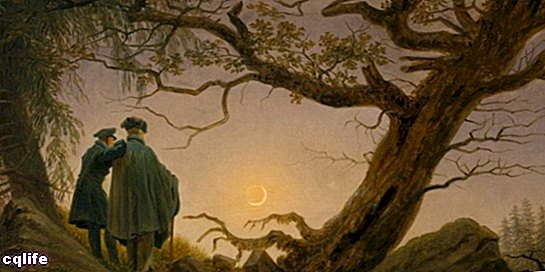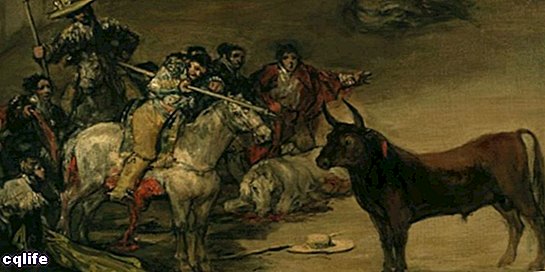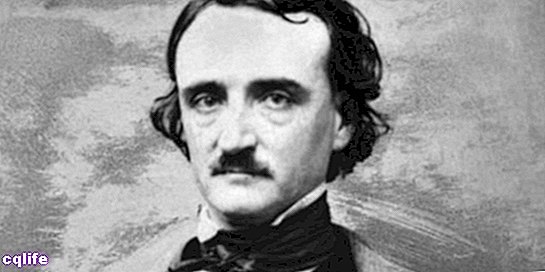- What is Romanticism?
- Origin and expansion of Romanticism
- Characteristics of Romanticism
- Romantic themes
- Authors of Romanticism
- Literary romanticism
- Musical romanticism
- Romanticism painting
- Romanticism architecture
We explain what Romanticism is and how this artistic movement arose. In addition, the topics it deals with and its main exponents.

What is Romanticism?
Romanticism was the artistic, cultural and literary movement that occurred at the end of the 18th century in England and Germany, later spreading to other countries ofEurope YAmerica.
Romanticism broke with the ideas of theIllustration and theNeoclassicism and sought to stand out through the music, the art and the literature the emotion that wild spaces awaken, thenature and the melancholy that it generates. Its main representatives used the incredible, the dreamlike and the implausible for artistic creation.
The term "romantic" should not be confused with its current meaning of romance.
See also:Baroque
Origin and expansion of Romanticism
There are those who consider as the beginning of Romanticism "The Lyrical Ballads", a collection of poems by William Wordsworth and Samuel Coleridge, from 1798. Other authors, however, claim that this movement began a decade earlier.
In Germany Romanticism in literature arose from the hand of Johann Wolfgang von Goethe, Clemens Brentano and the Brothers Grimm. Within the scope ofphilosophy They stood out: Johann Friedriche Schelling, Gottlieb Fitchte, Georg Wilhelm Friedrich Hegel, and Immanuel Kant.
After theFrench Revolution In 1789, Romanticism penetrated France with authors such as François-René de Chateaubriand, Alexandre Dumas, Théophile Gautier, and Victor Hugo. The latter wrote the preface to Cromwell (a work written in 1827) which was taken as a manifesto of the romantic movement.
Romanticism came to the United States from writers such as Edgar Allan Poe, James Fenimore Cooper, and Washington Irving.
In Spain it had its heyday around 1830, but it was a short period, since in 1840 there was already talk ofRealism. Among the most prominent exponents of Romanticism in Spain we can mention the writers: Mariano José de Larra, Enrique Gil y Carrasco and Gustavo Adolfo Bécquer and the painter Francisco José de Goya.
In Latin America This movement came as a way of rescuing indigenism and the national past, the authors who stood out were Esteban Echeverría, Andrés Bello and José Mármol, among others.
Characteristics of Romanticism
- Individualism. It exalts the figure of the individual as the center of creation.
- Originality. It seeks to establish subjective expression as the center of creative production.
- Nationalism. Exalts the values, history and identity of the culture of a people prior to neoclassicism.
- Emotionality Emphasizes emotions, passion, imagination and feelings over reason.
- Rejection of Neoclassicism. Put aside the traditions of the previous era and seeks to break with the classical and academic norms.
Romantic themes
- The exaltation of the self, individualism and subjectivism in art. Man is interested in his interior, he begins to take individual taste and not universal beauty.
- The rebellious, idealistic, nonconformist and dreamer hero.
- The melancholy as a reflection of an inner breakdown.
- Disappointment, romantics reject their time and feel that life is unfair and fleeting.
- Evasion as a means of escape from that life of disenchantment (that's why they like what Gothic, the exotic and medieval ruins).
- Wild and hostile nature is no longer written about the tamed nature of Neoclassicism, but about woods, scenery Y moutains raging (for the romantic man, nature is an organic and living whole).
- TheLiberty, especially in poetic forms (the poet is no longer tied to the rigorous laws of classical meter).
- Originality is essential as well as creativity against the imitation and static literature of Neoclassicism.
- Love anddeath, the romantic appreciates love for love itself but also reminds him of the finiteness of life and proximity of thedeath.
- The poet is a demiurge, that is, he is a creator.
- The unfinished and imperfect work is better than the closed and finished work.
Authors of Romanticism

Goya is one of the most important painters of Romanticism and art in general.
Among the most prominent representatives of Romanticism in letters, music and painting is it so:
Letters:
- Johann Wolfgang von Goethe (1749 -1832). German poet and novelist, together with Johann Gottfried Herder created "Sturm und Drang", the literary movement that started German Romanticism with ideas such as individuality, the artist's subjectivity and emotionality. Among his most outstanding works are: "Faust", "Prometheus" and "The misadventures of young Werther."
- Alexander Dumas (1802 - 1870). French novelist, he was a representative of the Romanticism of that country and also excelled in dramaturgy. His work acquired great popularity with titles such as "The Three Musketeers" "The Count of Monte Cristo" and "Twenty Years Later".
- Victor Hugo (1802 - 1885). Poet and playwright, he is considered one of the most important French authors in history and one of the main exponents of literary Romanticism. Among his most outstanding works are: "Les Miserables", "Our Lady of Paris" and "Cromwell".
- Edgar Allan Poe (1809 -1849). American writer and poet, is a world reference of the story short. In addition, it contributed to the development of the gothic novel, horror stories, detective stories and the Science fiction. Among his most recognized stories are: "The Black Cat", "The Raven" and "The Crimes of Morgue Street."
- Emily Brontë (1818 - 1848). British writer, her work "Wuthering Heights", which she wrote under a male pseudonym, is considered the highest expression of English literary Romanticism.
- Gustavo Adolfo Bécquer (1836 -1870). Spanish poet, he also excelled in narrative and journalism. He was part of a late Romanticism and is recognized for his lyric full of sensitivity, among his most outstanding works are: "Rimas" and "Letters from my cell."
Music:
- Ludwig van Beethoven (1770 - 1827). German composer and pianist, he was recognized worldwide for his works for piano and symphonies such as "Symphony 9" and "Symphony 5". It represented the ends of German classicism and the beginnings of Romanticism.
- Carl Maria von Weber (1786 - 1826). German composer and conductor, he composed operas such as "The Poacher" and "Oberón".
- Franz Schubert (1797-1828). Austrian composer with great posthumous popularity, he excelled in composing symphonies, operas, and sacred music.Among his most recognized works are: “Quinteto La trucha” and “Sinfonía uncabada”.
- Frederic Chopin (1810-1849). Polish composer and pianist, he was a reference of European Romanticism with outstanding works such as: “Nocturnos, op 9” or “Heroic Polonaise”.
- Richard Wagner (1813-1883). German composer and conductor, he carried out the composition and production of operas such as "Tristan and Isolde", "The Ring of the Nibelung" and "The Valkyrie".
Art:
- Francisco José de Goya (1746 - 1828). Spanish painter, is considered one of the most important artistic references in the world. In his work the oils stand out, drawings and murals. "The naked maja", "The dressed maja" and "The family of Carlos IV" are some of his most representative works that are in the Prado Museum in Madrid.
- William Blake (1757-1827). English painter and poet, he used both disciplines together to create works such as "The Ancient of Days", "Newton" and "Nebuchadnezzar".
- Caspar David Friedrich (1774-1840). German painter, is considered a benchmark of 19th century Romanticism in that country. In his works such as "The walker on the sea" and "Abbey in the oak grove" stands out the use of oil on canvas with representations of landscapes.
- Joseph Mallord William Turner (1775-1851). English painter, stood out in the representation of landscapes in oil and watercolor in which he portrayed the relationship between nature and the human being. Among his most recognized paintings are: "The shipwreck", "Snow storm" and "The burning of the houses of Parliament".
- Eugene Delacroix (1798-1863). French painter exponent of 19th century Romanticism, his work is characterized by the intensity of the colors and deals with topics such as war, freedom and religious issues. "Freedom guiding the people" and "The death of Sardanápolo" are two of his most recognized works.
Literary romanticism

Literary Romanticism was the literary aspect that developed during Romanticism from the 18th century. It was born in Germany and then spread to the rest of Europe and America.
The works produced during this period were characterized by being a channel to convey emotions in which reason is set aside to privilege the imagination.
The literature of this time breaks with the classical and academic structures. Develop new formats and genres such as the Gothic novel or the historical novel. In addition, it rescues the national identity and the cultural heritages of the past.
The artists of Romanticism were characterized by seeking creative freedom and highlighting their individuality and subjectivity when using the writing To convey their emotions and sensitivity, they used nature as a source of inspiration. The figure of the romantic writer is extended as a rebellious individual mired in feelings of melancholy and incomprehension.
Musical romanticism
Musical Romanticism was the musical expression within the current of Romanticism that began in the 18th century, it was characterized by the search for the expression of emotions and feelings through music.
The artists who were part of this movement were looking for a freer musical field in which they could compose and perform in a more expressive and personal way.
During this period there was a growth of the orchestras with the incorporation of new instruments, a development of the symphony and the lyrical. In Romanticism many of the most popular compositions in history were made that still survive, such as the symphonies of Ludwig van Beethoven or the operas of Richard Wagner.
Romanticism painting

The painting of Romanticism developed from the eighteenth century and was characterized by giving visibility to emotions, suffering and rescuing the heritage of medieval culture in opposition to neoclassicism.
The artists of this movement gave value to subjectivity and individuality, leaving aside reason and privileging the dreamlike, passion, imagination and the irrational. They worked according to the dictates of inspiration and not commissioned.
In the romantic works, the representation of landscapes, the use of nature as a source of inspiration and its relationship with the human being stand out.
Romanticism architecture
The architecture From Romanticism he sought to put an end to the classical style and for that he made use of styles that were used in earlier times such as Gothic and Byzantine.
Romanticism took the bases of medieval architectural styles and added characteristics and details typical of this new period (Historicism). These adaptations varied according to each country, and the prefix "neo" was prefixed to differentiate them from the originals.
Among the most used were: neo-Gothic, like Fonthill Abbey in England; Neo-Byzantine, such as Sophia Cathedral in St. Petersburg, Russia, and Neo-Romanesque, such as Neuschwanstein Castle in Germany.
